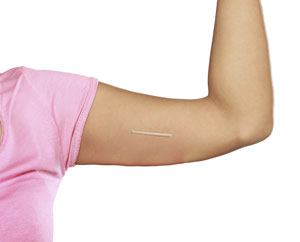Nexplanon

What is Nexplanon?
Nexplanon is a type of contraceptive implant which are birth control devices for women which provide long-term protection. Nexplanon is a flexible plastic rod about the size of a matchstick that is placed under the skin of the upper arm. The implant releases a hormone called progestin which prevents pregnancy by suppressing ovulation or preventing the release of an egg each month. The implant thickens the mucus in your cervix to prevent sperm from entering your uterus. It also thins the lining of the uterus (endometrium) to prevent a fertilized egg from implanting.
How is Nexplanon Placed?
The procedure is performed at your doctor’s office in less than a minute. Your doctor injects local anesthesia on your upper arm where the implant is inserted. A device is used to insert the implant beneath your skin. You may feel a slight pressure during insertion. You will be able to feel the implant but won’t be able to see it after insertion.
Nexplanon is kept in place for three years and then must be removed and replaced in order to continue to prevent pregnancy. Removal takes around 10-20 minutes. Your doctor numbs your skin with local anesthesia and makes a small incision near the tip of the implant and pulls it out. An X-ray can help locate the device if your doctor can’t feel it.
Advantages of Nexplanon
Advantages of Nexplanon include:
- Highly effective
- Easy and comfortable to use. There is no risk of incorrect use or overuse.
- It is long-lasting and reversible
- Menstrual pain is lessened with the use of the implant.
- You can become pregnant immediately after removal.
Disadvantages of Nexplanon
Potential disadvantages of Nexplanon include:
- It is more expensive than most other forms of contraception.
- It does not provide protection against sexually transmitted diseases.
- Can be associated with irregular bleeding or spotting in up to 20% of women
Risks of Nexplanon
As with any procedure, Nexplanon is associated with certain risks which include:
- Bruising, swelling, pain or redness at the insertion site
- Infection and scarring
- Irregular periods
- Depression
- Pain in the abdomen or nausea
- Acne
- Headache
Related Topics
- Colpocleisis
- Pessary Fitting
- Clomid/Letrazole
- Uterine Septoplasty
- Office Hysteroscopy
- Cervical Biopsy
- Colposcopy
- Endometrial Ablation
- Endometrial Biopsy
- Excision of endometriosis
- Laparoscopy
- Hormone Replacement Therapy (HRT)
- Hysterectomy
- Hysteroscopy
- Intrauterine Device (IUD)
- Laparoscopic Ovarian Cystectomy
- LEEP
- Mona Lisa Touch
- Myomectomy
- Nexplanon
- Pre-conception Planning
- Robotic-Assisted Gynecology Surgery
- Sterilizations
- In-office Ultrasound
- In-office Procedures
